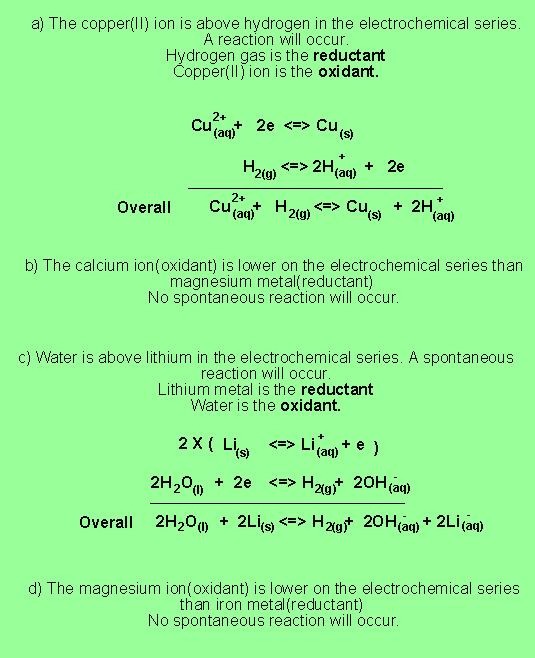
e) See your teacher for solution
Hide solution

e) See your teacher for solution
Hide solution
Solution
Cell emf = highest (half cell emf)- lowest (half cell emf)
a) Copper half cell = 0.34V
Hydrogen half cell = 0.00V
Cell emf = 0.34 -0.00V = 0.34V
b) Copper half cell = 0.34V
Iron half cell = -0.41V
Cell emf = 0.34 - - 0.41V = 0.34 + 0.41 = 0.75V
c)
Iron half cell = -0.41V
Hydrogen half cell = 0.00V
Cell emf = 0.00V --0.41= 0.00 + 0.41V = 0.41V
d)
Permanganate ion = 1.49
Hydrogen half cell = 0.00V
Cell emf = 1.49 -0.00V = 1.49V
e)
Magnesium half cell = -2.38V
Iron half cell = -0.41V
Cell emf = -0.41 - -2.38V = -0.41 + 2.38 = 1.97V
Hide solution
Remember. Oxidation always occurs at the anode (-) while reduction occurs at the cathode(+).
a)
![]() and
and ![]()
Reduction = cathode (+) ------------------------![]()
Oxidation
= anode (-) ---------------------------- ![]()
b) ![]() and
and ![]()
Reduction
= cathode (+) ------------------------![]()
Oxidation
= anode (-) ---------------------------- ![]()
c)![]() and
and ![]()
Reduction = cathode (+) ------------------------ 2H+(aq) + 2e <=> H2(g)
Oxidation
= anode (-) ---------------------------- ![]()
d)![]() and
and
![]()
Reduction
= cathode (+) -----------------![]()
Oxidation
= anode (-) ---------------------------- ![]()
e)![]() and
and
![]()
Reduction
= cathode (+) ------------------------![]()
Oxidation
= anode (-) ---------------------------- ![]()
Hide solution
|
Potential difference. Exercises |
|
|
|
|
|
1) Using the table above predict if a reaction will occur and write the reaction when: a) hydrogen gas is bubbled
through a solution of copper nitrate. Solution 2) Using the table above calculate the emf of the cell created when the following half cells are connected. a) b) c) d) e) Solution 3) In question 2) above indicate
the reaction occuring at the anode and at the cathode. Indicate the
direction of electron flow. Solution |